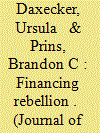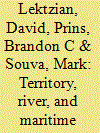|
|
|
Sort Order |
|
|
|
Items / Page
|
|
|
|
|
|
|
| Srl | Item |
| 1 |
ID:
172166


|
|
|
|
|
| Summary/Abstract |
Do UN peacekeeping forces protect civilians from harm in post-war environments? Current evidence suggests that the answer to this question is yes. But extant research mostly examines this relationship at the country-level and consequently has logical difficulty tracing decreases in civilian fatalities to actual peacekeeper activities. We would have more confidence in the ability of peacekeepers to limit harm and protect non-combatants if the reduction in violence occurred locally where blue helmets were positioned. Using original geocoded data of yearly UN deployments in four Sub-Saharan African conflicts (Sudan, South Sudan, Democratic Republic of Congo, and Ivory Coast), we find that peacekeeping units get locally deployed to violent post-war areas and they reduce the level of civilian harm almost immediately. But, in areas without violent clashes between government forces and rebels, we find peacekeeping units more responsive to civilian targeting by rebels, which indicates a reluctance among peacekeepers to confront government forces that target civilians. While host nation consent is crucial for the success of a peacekeeping mission, the findings from this study caution against nurturing illiberal regimes by failing to check government atrocities. The failure to confront government abuse can jeopardize long-term peace and reconciliation.
|
|
|
|
|
|
|
|
|
|
|
|
|
|
|
|
| 2 |
ID:
152299


|
|
|
|
|
| Summary/Abstract |
A prominent explanation of the resource–conflict relationship suggests that natural resources finance rebellion by permitting rebel leaders the opportunity to purchase weapons, fighters, and local support. The bunkering of oil in the Niger Delta by quasi-criminal syndicates is an example of how the black-market selling of stolen oil may help finance anti-state groups. More systematic assessments have also shown that the risk and duration of conflict increases in the proximity of oil and diamond deposits. Yet despite the emphasis on rebel resource extraction in these arguments, empirical assessments rely almost exclusively on latent resource availability rather than actual resource extraction. Focusing on maritime piracy, this article argues that piracy is a funding strategy neglected in current research. Anecdotal evidence connects piracy in the Greater Gulf of Aden to arms trafficking, the drug trade, and human slavery. The revenue from attacks may find its way to Al-Shabaab. In Nigeria, increasing attacks against oil transports may signal an effort by insurgents to use the profits from piracy as an additional revenue stream to fund their campaign against the Nigerian government. The article hypothesizes that piracy incidents, that is, actual acts of looting, increase the intensity of civil conflict. Using inferential statistics and predictive assessments, our evidence from conflicts in coastal African and Southeast Asian states from 1993 to 2010 shows that maritime piracy increases conflict intensity, and that the inclusion of dynamic factors helps improve the predictive performance of empirical models of conflict events in in-sample and out-of-sample forecasts.
|
|
|
|
|
|
|
|
|
|
|
|
|
|
|
|
| 3 |
ID:
100272


|
|
|
|
|
| Publication |
2010.
|
| Summary/Abstract |
Some studies find that democratic states are more amenable to third party forms of conflict management, while other studies indicate that democracies are able to resolve contentious issues on their own through bilateral negotiations. Using data from the Issue Correlates of War (ICOW) Project, the authors investigate peaceful and militarized conflict management strategies that democratic states employ to resolve contentious issues. Theoretically, the authors focus on how militarized conflict history, relative capabilities, and issue salience influence the tools of conflict management employed by democratic states. Empirical analyses suggest that democratic dyads employ bilateral negotiations more often to resolve contentious issues when the issue has not been militarized previously, when the issue is more salient, and when democratic states face equal adversaries. Democratic dyads seek out nonbinding third party settlement more frequently in situations of power preponderance than nondemocratic dyads, although binding forms of third party settlement occur most often in relatively equal democratic dyads. When it comes to the use of force, democratic states are much less likely than their authoritarian counterparts to militarize an issue claim when little or no armed conflict characterizes the relationship. However, democratic leaders show a willingness to confront force with force. After one militarized dispute, democratic states are no different in their conflict propensity than autocratic states.
|
|
|
|
|
|
|
|
|
|
|
|
|
|
|
|
| 4 |
ID:
137818


|
|
|
|
|
| Summary/Abstract |
This paper extends systematic analyses of maritime piracy by verifying the robustness of empirical results and examining the forecasting ability of empirical models. Recent research by Ward, Greenhill and Bakke (2010) finds that statistically significant relationships frequently offer poor guidance when it comes to anticipating the inception of civil war. We assess the predictive ability of purported causal factors of piracy using evaluative statistical tools such as receiver-operating characteristic plots, out-of-sample predictions, and outlier analysis. Statistical results for in-sample and out-of-sample tests show that while factors such as military capacity, population size, coastline length, and trade volumes are statistically related to piracy, state fragility has by far the strongest predictive effect despite only being moderately statistically significant in the models. Outlier analysis demonstrates that while several countries experience higher numbers of piracy incidents than predicted, empirical models are generally robust to the presence of outliers. For policymakers, the findings suggest that counter-piracy efforts focused on capacity-building measures have the greatest potential for reducing the piracy threat.
|
|
|
|
|
|
|
|
|
|
|
|
|
|
|
|
| 5 |
ID:
058798


|
|
|
| 6 |
ID:
083441


|
|
|
|
|
| Publication |
2008.
|
| Summary/Abstract |
This article argues that the systemic security environment influences the structure of domestic political and economic institutions. If states have been primarily created to protect one group from predation by another, then the state may visibly change as external threats rise and fall. The authors argue that political elites respond to threatening environments by enhancing the ability of the state to extract resources from society in order to protect itself. Using data from the Armed Conflict Dataset, Banks's Cross National Data Archive, and COW data from 1975 to 1995, the authors find evidence that supports the conjectured relationship between threat and state strength. As a response to a more threatening environment, the authors find that states significantly increase their capacity in terms of revenue, government spending, and military spending, but they do not easily relinquish these gains. The authors also observe that nation-state security is heavily influenced by regional regime-type patterns. State capacity increases as the regional neighborhood becomes increasingly autocratic. This suggests political elites not only regard violent conflict in the region as a serious concern to national security, but also appear to consider political change a threat as well
|
|
|
|
|
|
|
|
|
|
|
|
|
|
|
|
| 7 |
ID:
101619


|
|
|
|
|
| Publication |
2010.
|
| Summary/Abstract |
Issues remain at the core of armed conflict. Territory, in particular, appears to increase substantially the probability of inter-state violence and is concluded by many to be one of the most critical correlates of war onset. While scholars have called for an issue-based approach to the study of international relations for some time, recent data collection efforts allow the emergence and management of contentious issues over time to be studied more directly. Our argument and evidence suggest that territory is not necessarily contentious by itself, but is contentious in dyadic contexts characterized by rivalry. Using data from the Issue Correlates of War project, which codes specific government assertions of ownership to territory, river, and maritime locations, we find strategic rivalry, coupled with territorial claims, produces some of the most conflict-prone dyads. Further, jointly democratic domestic institutions do not appear to reduce the hazard of violent conflict over territorial issues within the context of rivalry, although they substantially reduce the hazard of violent conflict among states outside the context of rivalry.
|
|
|
|
|
|
|
|
|
|
|
|
|
|
|
|
|
|
|
|
|